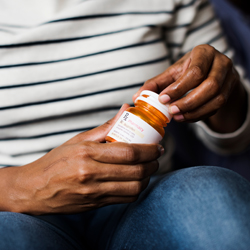By Marie Rosenthal, MS
In a 16-to-2 vote, an FDA advisory committee recommended approval of emtricitabine–tenofovir alafenamide (F/TAF; Descovy Gilead) to be used for pre-exposure prophylaxis (PrEP) to reduce the risk for HIV infection in certain populations, but said there were not enough data to recommend approval for all at-risk individuals.
Gilead is seeking an indication for the oral fixed-dose combination of 200 mg of emtricitabine and 25 mg of tenofovir alafenamide taken once daily for at-risk adults and adolescents weighing at least 35 kg, which is the same indication given to emtricitabine–tenofovir disoproxil fumarate (F/TDF; Truvada, Gilead).
Although most committee members agreed that Gilead provided evidence for the safety and efficacy of F/TAF for PrEP among men who have sex with men (MSM) and transgender women who have sex with men, they did not think the company provided enough data to recommend a PrEP indication that included cisgender women (a vote of 10-to-8 against approval).
In addition, the committee had a problem with those insufficient data. In fact, the data on both cisgender and transgender women took up most of the discussion during the daylong meeting. Several of the members who voted in favor admitted they considered voting no or abstaining from the vote because of the lack of clinical data on cisgender women. They also thought that not enough transgender women and minorities of both sexes were represented.
“So, question one was 16 to 2, but even among those who voted no, there was a large consensus and viewpoint that the data do support efficacy—however, it’s in the population studied [which was mostly MSM],” summarized Lindsey Baden, MD, the chair of the Antimicrobial Drugs Advisory Committee (AMDAC).
Dr. Baden likened the committee’s decision to the character Martin Arrowsmith, from the Pulitzer Prize–winning eponymous novel by Sinclair Lewis. “I feel like Arrowsmith: We’re in a desperate situation, so let’s do something because we can do something,” he said, insisting it would be “presumptuous” to “hang our hats” on just partial data.
He added that the pharmacokinetic studies in cisgender women did not provide enough information to make a recommendation on the product’s safety and efficacy for that group. In addition, there were concerns about some safety signals, including weight gain and lipid profiles. “Those would have to be carefully followed and monitored in a postmarketing setting, and the database expanded in key at-risk populations, especially among transgenders,” said Dr. Baden, who is also the director of clinical research in the Division of Infectious Diseases at Brigham and Women’s Hospital, as well as director of the infectious disease service at Dana-Farber Cancer Institute and a professor at Harvard Medical School, all in Boston.
Clinical Trial Data
The AMDAC reviewed interim data from the ongoing phase 3 multinational DISCOVER trial, which is evaluating the safety and efficacy of an oral fixed dose of emtricitabine 200 mg and tenofovir alafenamide 25 mg with F/TDF in men and transgender women who are at high risk for sexually acquired HIV infection. In addition, Gilead presented two phase 1 pharmacokinetic studies to support the extrapolation of the efficacy of F/TAF in cisgender women.
The DISCOVER trial randomly assigned 5,387 people to F/TAF or F/TDF. Almost all of the patients were MSM. Only 1.4% of the study population were transgender women. (Among the 74 transgender women who were treated, 26 prematurely stopped taking the study drug and 24 dropped out after the cutoff date.)
Eligible adults enrolled in the study met at least one of the following criteria: condomless anal intercourse in the past 12 weeks with multiple men who were HIV-positive or whose status was unknown, or a documented history of syphilis, rectal gonorrhea or chlamydia within the past 24 weeks of study entry.
In follow-ups at weeks 4 and 12 and every 12 weeks thereafter, patients received additional study medication and were tested for HIV and other sexually transmitted infections, including hepatitis B and C. Monitoring included a physical examination, weight and vital sign measurements, drug plasma and creatinine concentrations, as well as self-reported adherence and recreational drug and alcohol use.
At weeks 48 and 96, bone mineral density studies were conducted in 400 patients.
The primary end point was noninferiority to F/TDF, measured as the incidence of HIV infection per 100 person-years. Secondary end points included bone and renal health of the patients.
Results from the DISCOVER trial demonstrated that F/TAF met the primary end point of noninferiority. Of the 5,335 participants, 22 (seven in the F/TAF arm; 15 in the F/TDF arm) developed an HIV infection. Additionally, statistically significant improvements in bone and renal laboratory parameters were observed in participants receiving F/TAF versus those receiving F/TDF.
“Importantly, the study met its primary end point, demonstrating noninferiority of Descovy to Truvada for the pre-exposure prevention of HIV infection among individuals randomized to DISCOVER—seven acquired HIV infection for an incidence rate of 0.16 per 100 person-years,” said Diana Brainard, MD, the senior vice president for HIV and Emerging Viruses at Gilead.
“In the Truvada group, there were 15 infections, resulting in an incidence rate of 0.34 for 100 person-years. The incidence rate ratio—the prespecified method for determining noninferiority—was 0.47 with an upper bound of the confidence interval less than the prespecified margin of 1.6,” added Dr. Brainard, who is also an infectious disease physician who has treated HIV infection in both the United States and Africa.
“I believe there’s substantial evidence of the safety [and] of the effectiveness to reduce the risk of sexually acquired HIV in the indicated population,” said Col. Peter J. Weina, PhD, MD, FACP, FIDSA, an advisory committee member who voted yes on the first question but no for cisgender women. Dr. Weina is the branch chief of Research Regulatory Oversight Office in the Office of the Under Secretary of Defense, Defense Health Headquarters in Falls Church, Va.
“Ignoring all the background politics, potential gamesmanship, market pressures, whatever—this is another product in our tool box that gives clinicians that option we didn’t previously have,” Dr. Weina said.
The AMDAC also evaluated pharmacokinetic data on F/TAF and F/TDF for HIV treatment and PrEP in support of the potential use of F/TAF for PrEP in cisgender women, a group that was not part of the DISCOVER trial.
To obtain the indication for cisgender women, Gilead suggested that the committee extrapolate efficacy data from the DISCOVER trial. The company demonstrated similar systemic pharmacokinetic exposures of TAF in plasma between the MSM and transgender women studied and cisgender women.
The company also suggested that the committee extrapolate efficacy from the F/TDF trial, which included cisgender women because TAF, a prodrug, hydrolyzes to tenofovir in the body. So efficacy could be shown by demonstrating similar or higher concentrations of tenofovir in peripheral blood mononuclear cells and cervicovaginal mucosal tissues, according to the company.
Although there are several products being studied, the only product currently indicated for PrEP is F/TDF, which received FDA approval for PrEP on July 16, 2012. The F/TDF approval was based on efficacy and safety data from two large, more inclusive, randomized placebo-controlled trials in diverse populations, including heterosexual HIV-discordant couples, MSM and transgender women. A later trial in young MSM, aged 15 to 17 years, expanded the indication to at-risk adolescents. F/TDF has proven to be highly effective in reducing the sexual activity–related risk for HIV infection. It also goes off patent in 2020.
Since then, PrEP has become the standard of care for HIV prevention and is a cornerstone of the federal government’s program, Ending the HIV Epidemic: A Plan for America. Although there has been an increase in PrEP use, the CDC estimates that only about 7% of the 1.1 million people in this country with an indication for PrEP were prescribed it in 2016.
The primary users of PrEP are white, urban, educated MSM, according to the CDC. People who are most at risk for infection, including cisgender minority women, transgender individuals, adolescents, injection drug users, minority group MSM, and residents of rural communities are not fully using PrEP.
One reason for F/TDF’s low uptake in some populations could be its association with renal failure, lactic acidosis, severe liver disease and fractures, according to Gilead. Company officials said F/TAF’s better overall safety profile might encourage more people to use PrEP.
Although F/TAF hydrolyzes to tenofovir in the plasma, it does so more slowly than F/TDF, keeping blood levels 90% lower in TAF users than TDF users, resulting in lower organ and tissue concentrations. This metabolic characteristic results in fewer bone and renal side effects, according to the company.
“The half-life of TAF is 75 times longer than that of TDF, which results in 90% lower plasma tenofovir levels. Descovy’s lower levels of circulating tenofovir translate to fewer clinically relevant adverse renal and bone effects,” Dr. Brainard explained. In addition, TAF reaches protective levels faster than TDF, she added.
However, F/TAF did have some safety issues that caused concern among the committee members, most notably higher lipid levels than F/TDF and weight gain, which would be a considerable problem as the HIV-positive population grows older.
Many committee members recommended that if the indication was expanded, postmarketing could only discuss noninferiority to FTC/TDF, not superiority.
“Collectively, these data demonstrate that Descovy is highly effective at preventing HIV acquisition, and demonstrates safety benefits over Truvada,” Dr. Brainard said.
The FDA approved F/TAF in April 2016 for the treatment of HIV-1 infection in adults and pediatric patients weighing at least 35 kg, in combination with other antiretroviral agents. It is not indicated anywhere for HIV prevention.
Although the FDA does not have to abide by the committee’s recommendations, it does consider panel deliberations and voting in its final decision regarding drug approvals.




